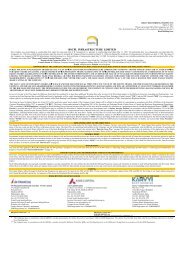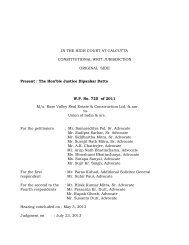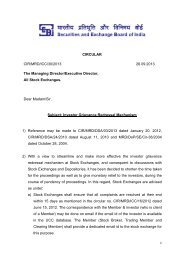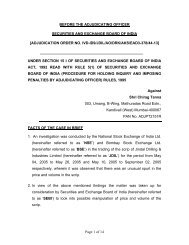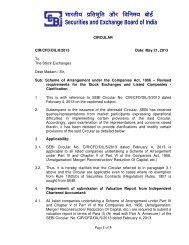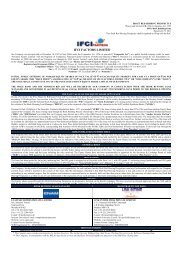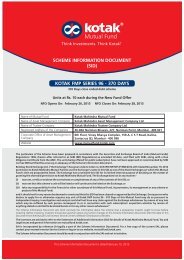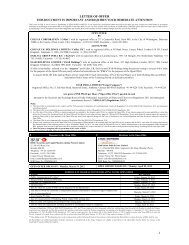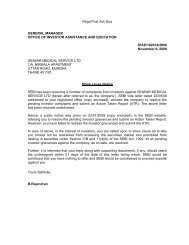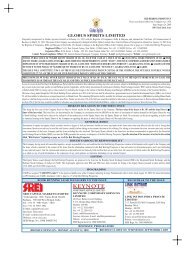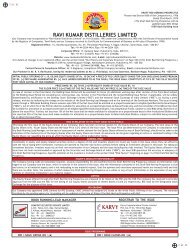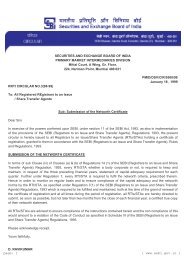KAMDHENU ISPAT LIMITED - Securities and Exchange Board of India
KAMDHENU ISPAT LIMITED - Securities and Exchange Board of India
KAMDHENU ISPAT LIMITED - Securities and Exchange Board of India
Create successful ePaper yourself
Turn your PDF publications into a flip-book with our unique Google optimized e-Paper software.
Price trend<br />
Sponge iron prices primarily depend on:<br />
· Scrap prices, as scrap can be substituted to an extent to manufacture steel<br />
· Dem<strong>and</strong> for steel<br />
· Prices <strong>of</strong> iron ore <strong>and</strong> coal, as they are the key inputs in the manufacture <strong>of</strong> sponge iron.<br />
Higher scrap prices may lead to increased usage <strong>of</strong> sponge iron in the input mix <strong>of</strong> the secondary route <strong>of</strong> steel<br />
making. The buoyancy in the steel industry has resulted in scrap prices touching an all time high <strong>of</strong> 300-325 USD/<br />
MT.<br />
The <strong>India</strong>n market<br />
(a) Dem<strong>and</strong><br />
The dem<strong>and</strong> for sponge iron in <strong>India</strong> has been growing at 8.25% CAGR over the last eight years (1996-2004). The<br />
dem<strong>and</strong> has been primarily driven by the following factors:<br />
· Increase in steel production via the secondary route accounting for 42-43% <strong>of</strong> the total steel output. This is<br />
expected to grow further due to shortage <strong>of</strong> coking coal, a key raw material for steel making via the primary route<br />
based on blast furnace.<br />
· Proportion <strong>of</strong> sponge iron in secondary production is also likely to go up, with low domestic availability <strong>and</strong> high<br />
international prices <strong>of</strong> scrap, a marginal substitute for sponge iron.<br />
· Availability <strong>of</strong> scrap will be constrained in the context <strong>of</strong> regulations relating to imports <strong>of</strong> low quality scrap to<br />
<strong>India</strong>.<br />
<strong>India</strong>n Sponge Iron Dem<strong>and</strong> (Mn Tonnes)<br />
(b) Supply<br />
<strong>India</strong> has emerged as the top most sponge iron producing country on the supply front in the last few years.<br />
<strong>India</strong>n Sponge Iron Production (Mn Tonnes)<br />
(c) Outlook<br />
1. Sponge Iron is an attractive investment option since entry barriers are very low with short gestation periods, low<br />
initial capital, indigenous technology <strong>and</strong> equipments, an assured market, early payback, a modular system <strong>and</strong><br />
an excellent growth potential. On the other h<strong>and</strong>, dem<strong>and</strong> for sponge iron is expected to create an incremental<br />
dem<strong>and</strong> <strong>of</strong> 1.3 Mn tonnes compared to 2.5 Mn tonnes <strong>of</strong> capacity additions. Thus, industry fundamentals <strong>of</strong> the<br />
sponge iron industry are expected to weaken over a few years, after which it would consolidate <strong>and</strong> stabilize at<br />
a higher level.<br />
2. As per industry analysts, the upturn in the global sponge iron industry is expected to continue <strong>and</strong> is pegged to<br />
grow at a CAGR <strong>of</strong> 6-7%. This growth is at a back <strong>of</strong> an increase in steel production <strong>and</strong> continuous substitution<br />
in dem<strong>and</strong> for scrap.<br />
3. Significant additions in capacities are expected with a buoyant dem<strong>and</strong> scenario. However, all capacities generated<br />
will not be able to function at an optimum operating rate due to scarcity <strong>of</strong> iron ore <strong>and</strong> coal. As per industry<br />
estimates, the <strong>India</strong>n coal requirement for 2004-05 was approximately 405 Mn tonnes against the availability <strong>of</strong><br />
370 Mn tonnes. As a result, the players are forced to use E <strong>and</strong> F grade <strong>of</strong> coal, resulting in lower yield. Therefore,<br />
players with captive raw material sources would emerge successful in long run.<br />
Since sponge iron substitutes scrap, scrap prices work as a cap for sponge iron prices. Unavailability <strong>of</strong> scrap<br />
globally <strong>and</strong> import restrictions would maintain the prices <strong>of</strong> scrap at higher levels, resulting in increased sponge iron<br />
prices.<br />
36



